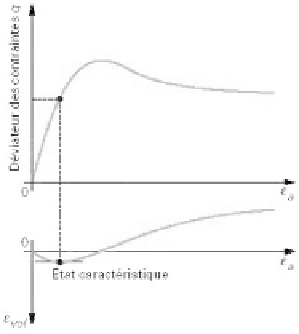Geoscience Reference
In-Depth Information
Dilatant
over-characteristic
LR
LC
Contracting
under-characteristic field
Characteristic state
LC
LR
(a)
(b)
Figure 9.4.
(a) Definition of the dilatancy angle and the characteristic line [LUO 80];
(b) signification of the characteristic state [MAG 91]
a given state and the critical state line or the state of zero volume change that some
researchers use in soil mechanics. In this case, we can introduce another angle, such
as:
M*
=
M
· p
− q
=
M
· p
−
M
· p
· F · r
=(1−F·r)
M
·p
[9.34]
It has been found that this dilatancy parameter integrates both the friction angle at
perfect plasticity and the state of the material (its position with respect to critical state
line). In this way, the role played by both the confinement and density is assembled
in function
F
. In this chapter, we do not use the latter definition of dilatancy unless
explicitly specified;
d) the evolution of
r
is obtained by deriving relations [9.17] or [9.22] with
respect to time:
n
p
−1
n
p
r
s
= λ
p
n
p
(r
s
)
2
(1 − (r
s
)
1/n
p
)
[9.35]
a
s
The parameter
a
s
controls changes in
r
s
(or
p
). This is an important parameter
of the model and adjusts the plastic stiffness. Its value is double during cyclic loading
(
a
m
= a
and
a
s
=2a
). It is easier to choose a constant value for
a
, but the parameter
may also evolve according to shear deformations. Hujeux [HUJ 85] proposes the
following relation which allows the two scenarios to arise, depending on the choice of





Search WWH ::

Custom Search